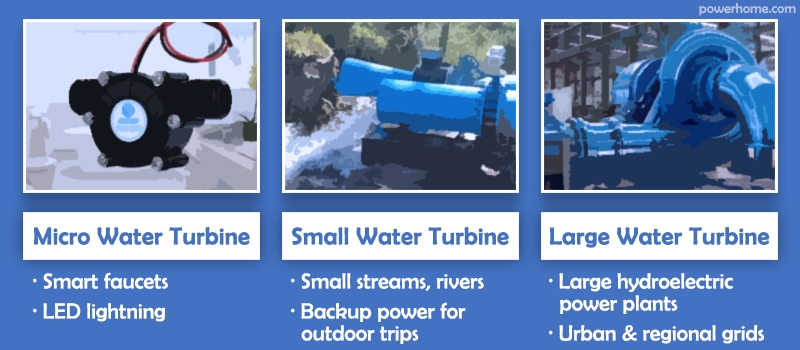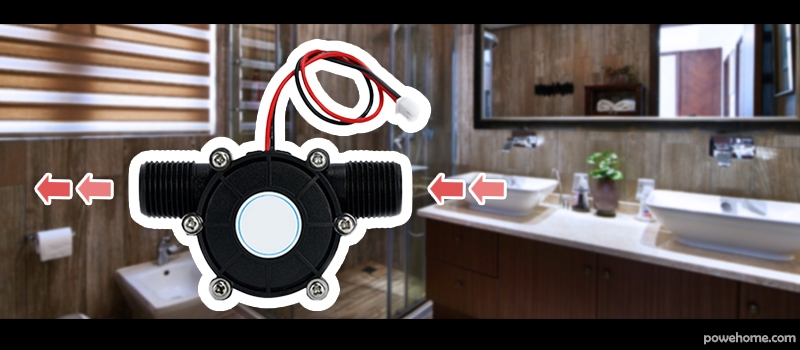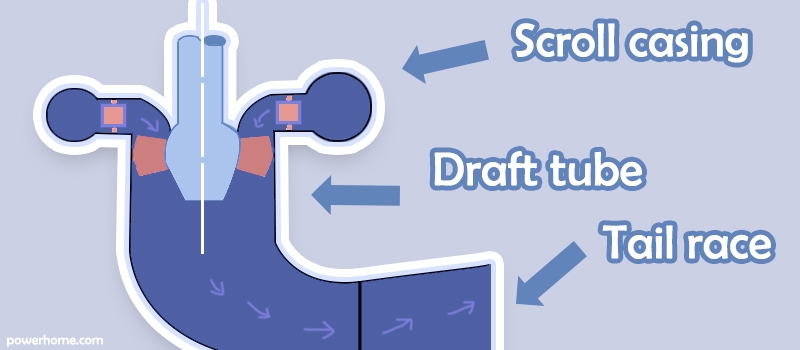Hydroelectricity is a technology that utilizes the energy of water flow to convert it into electricity. Water is a clean, renewable energy source, and due to the simplicity of energy access, hydro turbine generators are becoming popular among new energy and outdoor enthusiasts. Because of the difference in size and scale, the applications of small water turbine generators and larger water turbine generators are completely different. This blog will introduce you to the application scenarios and usage of micro and small water turbine generators under 1kW and large water turbine generators respectively.
Applications of Water Turbine Generator

Micro Water Turbine Generator
These water-power turbine generators are very small and generally do not produce large amounts of electricity, most of the time they are used as an auxiliary power source to reduce electricity consumption in the home and to promote the use of renewable energy to build off-grid green homes. They can generally be used for:
- Fish tank LED lighting;
- Smart faucets and sensor faucets;
- Shower lighting;
- Temperature-inducing showerheads;
- Gas water heaters.
Small Water Turbine Generators
They are slightly larger than micro water turbine generators, but still fall into the category of small hydro generators, which can solve small-scale power needs for people who like to travel outdoors. Small hydro generators are typically used for:
- Small streams, rivers or water sources with low flow rates;
- Small industrial units or farms in remote areas;
- Combining with other renewable energy sources such as solar and wind to power homes;
- Backup power for outdoor trips, hikes, and adventures.
Large Water Turbine Generators
This type of hydroelectric generator usually refers to facilities with an installed capacity of tens to thousands of MW, enough to power a plant and an entire house, for both personal and commercial use, and they are primarily utilized:
- Rivers, dams, or reservoirs with high flows;
- Large hydroelectric power plants on a national scale;
- Urban suburbs and industrial areas;
- As one of the sources of power supply for urban and regional grids.
How to Use
Next, two water turbine generators sold in the PowerHome store will be used as examples of how to use them.
This 12V micro water turbine generator is intended for home use and is characterized by its shape by the hollow pipe at the top. The pipe has an outer diameter of 20mm and an inner diameter of 13mm, which allows you to connect a standard household water pipe to it, allowing the water to flow through the pipe to the fan blades below, driving the generator to run and generate electricity.

In a nutshell, the steps for its use are:
- Choose a suitable location to install it, making sure there is enough space for the connection box to easily disconnect the water flow.
- Connect the water pipe and connect the output wires to the controller or storage system. If you are powering an appliance directly, you need to make sure that the appliance voltage and frequency match the output of the generator.
- Turn on the faucet or showerhead and allow the water to flow through the micro-hydro generator to produce an electric current.
In a nutshell, the steps for its use are:
This 1kW axial flow water turbine generator is mainly used in places where the water drop is relatively low, such as, by a small river, by a small dam and so on. Its installation is more complicated than the above micro hydro generator, this is based on its working principle. Therefore, it needs additional installation of scroll casing, draft tube and tail race, as shown in the figure:

The following steps need to be followed when using it:
- Plan the installation site, usually near the rock installation and construction will be more solid.
- The length of the draft tube, i.e. the water fall, is called the head. Small axial flow hydraulic turbines generally have a head between 1 and 6 meters. After determining the length of the head, prepare materials such as concrete and stone bricks according to the quantity.
- Build the inlet channel with concrete and stone bricks, make the switch sluice with wooden boards, and make the trash baffle with wire mesh to form the inlet system.
- Depending on the model of water turbine, build a scroll casing with a spiral plane so that the water forms a vortex and drives the turbine to rotate.
- Under the spiral plane, build a draft tube with a small top and a large bottom, flared. Its main function is to let the water form suction inside, so as to produce strong power to drive the generator work.
These are the two types of water-powered turbine generators. If you also want to experience hydroelectricity, welcome to visit PowerHome to purchase a water turbine generator. It is important to note that micro water turbine generators for home use usually only produce a very small volume of electricity, which may only be enough to power small appliances such as cell phones, LED lights, and so on, and will not be able to meet the needs of all appliances in the home. As such, they are better suited as a secondary sustainable energy solution rather than a primary power source.
(1).png)
(1).png)